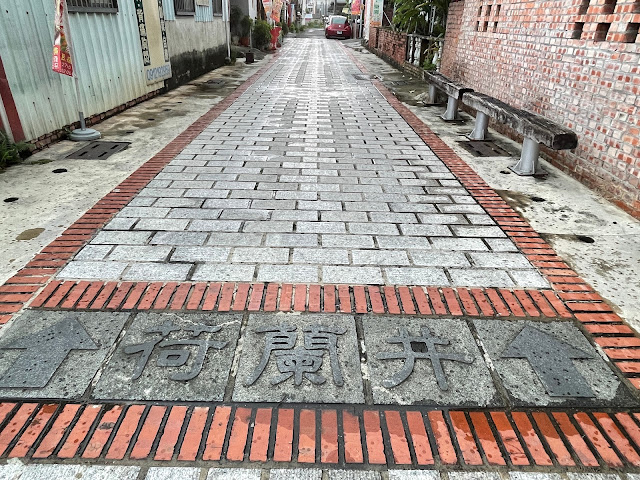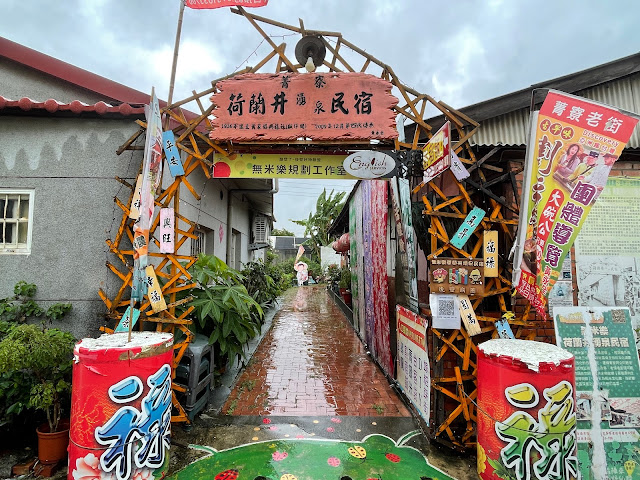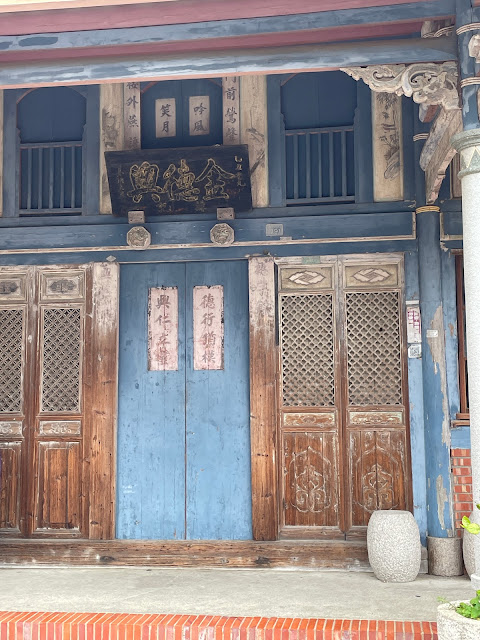Despite the rain, we went out for a drive, which was a rare occurrence during those busy months when my husband was mostly in Hsinchu. Due to the continuous rain, we mostly stayed indoors. We drove to Houbi, which was our first time visiting. Although the weather prevented us from seeing much, as it would start raining each time we left the car, we managed to see the old street, an old wooden school (unfortunately, no pictures as it was during school hours), an old wooden Japanese-style dormitory, and many old houses along the way. There were still some things we couldn't see, so I hope to return another time, perhaps on a weekend instead.
Since it was a weekday and raining heavily, Jingliao Old Street was actually empty.
Jingliao Old Street (菁寮老街)
Jingliao was a small village in the mid-Qing Dynasty, known for its dyeing and weaving crops. It served as an important halfway station on the ancient official road between Fucheng (Tainan) and Zhuluo County (Chiayi). It became the most prosperous settlement along the Bazhang River and was commonly known as "Beishi Street." During the Japanese occupation of Taiwan, the street was renovated, and the buildings facing the street were converted into commercial street houses.
The Jingliao Old Street in Houbi District is a historic street that dates back to the Qing Dynasty. It's known for its well-preserved traditional architecture and is a popular destination for tourists interested in experiencing Taiwan's rich cultural heritage.
The street is lined with old brick buildings, wooden houses, and storefronts that have been restored to their original condition. You can explore the narrow alleyways, which are filled with shops selling traditional handicrafts, snacks, and souvenirs.
One of the main attractions of Jingliao Old Street is the Jingliao Temple, a Taoist temple dedicated to the god of war - Guan Yu. The temple dates back to the Qing Dynasty and is known for its intricate wood carvings and colorful murals.
Another popular attraction is the Jingliao Ecological Park, which is located just outside of the old street area. The park offers a chance to explore the local flora and fauna, including rare bird species and freshwater turtles.
See also: Japanese-era Remains in Houbi
Jingliao Jin Dexing Pharmacy (菁寮金德興藥舖)
Jingliao Jin Dexing Pharmacy, also known as the Jingliao Ruan Family Ancient House, is a traditional wooden loft-style street house on Jingliao Old Street. It was moved to Jingliao in 1910 and is adorned with exquisite craftsmanship. It is also recognized as one of the top 100 scenic spots in southern Taiwan. In 2005, it was registered as a monument in Tainan City.
The building has changed ownership several times. It originally belonged to a prominent Lin family in Dingtan Village, Lucao Township, Chiayi County. It was later sold to Xu Qian in Houbi. In 1910, the building was dismantled and relocated to its current site in Jingliao, where it was sold to Ruan. Ruan opened a Chinese pharmacy, and the building also became the ancestral residence of the Ruan family. The plaque above the gate beam, "Jin Dexing Qian Ji," was inscribed by the calligrapher Jing Tang in 1925. One of the paintings on the wall, "Twelve Precepts of Tao Zhugong," was written by the owner of the house, Ruan Qian, in 1917. Admission to see the building and courtyard inside is 50NT.
Jingliao Holy Cross Catholic Church (菁寮聖十字架堂)
Jingliao Holy Cross Catholic Church, built from 1955 to 1960, was initially managed by the Franciscan Order but was later transferred to the Convent of St. John. The church building was designed by German architect Gottfried Bohm, who won the Pritzker Architecture Prize in 1986. The church's architectural value and significance in Taiwan have been recognized. The church is dedicated to St. Rudek, and inside, there is a niche on the left side of the sanctuary containing a small cross with fibers from the True Cross and the relic of Santa Maria Greti. The building of the Holy Cross Church features four pyramid spires, known as the "Bell Tower," "Baptistery," "Temple," and "Holy Body Chapel." Its distinctive feature is the aluminum skin covering the pyramid spires, with different Christian symbols at the top, including a "rooster," "dove," "cross," and "crown," representing the special meaning and function of these ceremonial spaces. The four pointed structures also resemble a tabernacle, symbolizing "the tabernacle where God dwells on earth."
厲園衍派
Unfortunately, the building is not accessible at the moment, but its architectural style is quite unique. I couldn't find much information about it. I don't know how to translate Chinese names into English either.







































0 komentarze:
Post a Comment